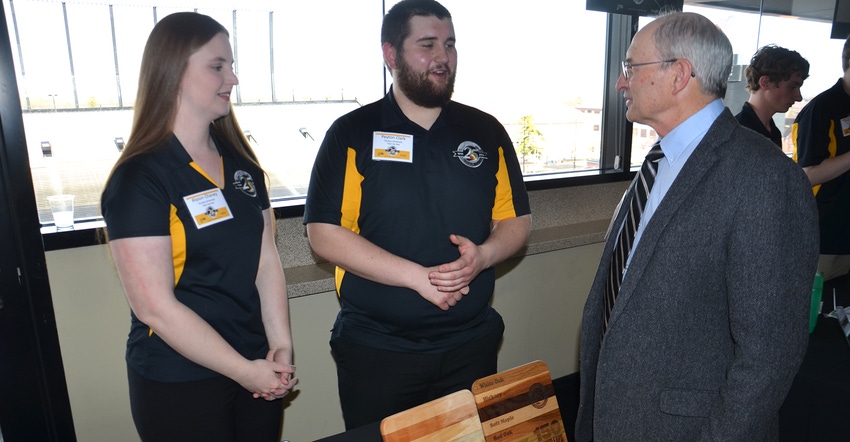
Maybe you’re not a master woodworker. Why should you care about Soy Seal, a potential new wood-sealing product? Woodworkers could use it to finish and protect wood surfaces instead of currently available products. The students who developed the concept provide several reasons why others should be interested. A farmer who visited with them adds another reason.
“One of our main ingredients comes from soybeans, which means it’s environmentally friendly,” explains Peyton Clark, Hillsdale, Ind., who worked with Alyson Chaney, Clinton, Ind., to develop the product. “In our testing so far, Soy Seal actually prevents scratching on the wood surface better than mineral oil.”
Most current wood sealers contain mineral oil, Clark says. They used it as the standard for comparison when testing their product. Clark adds that the product they developed from nanocellulose from soybeans conditions the inside of the wood while protecting the outside surface.
Pesky moisture rings
If your spouse has ever complained when you set a glass on a wood surface and it left a moisture ring, here’s another reason to like Soy Seal. Clark and Chaney report it is as good or slightly better than mineral oil at protecting wood surfaces from that type of abuse.
Time will tell if the students’ efforts pay off in a commercial product. They debuted it to invited guests at the award ceremonies held to recognize 2019 Student Soybean Product Innovation Competition winners and to celebrate 25 years of the competition. Purdue University hosted the awards event as part of its 150th yearlong celebration of its founding.
One guest was so interested that he took the students’ business card so he could follow up. And Dave Rodibaugh, a crop and hog farmer from Rensselaer, Ind., spent time talking to the pair because he’s hopeful their product might lead to a new use that adds to demand for soybeans.
Rodibaugh is a director on the Indiana Soybean Alliance board. ISA has funded the soybean new-uses competition through checkoff dollars provided by soybean growers since the competition began in 1994. The north-central Indiana soybean grower likes to promote any potential new use for soybeans. He and others are hopeful that Purdue University’s decision to switch to high-oleic soybean cooking oil in three of the five food courts serving student dormitories on campus will help spark additional interest in soy cooking oil.
Perseverance pays off
Clark and Chaney began their quest to develop a potential new product made at least partially from soybeans over six months before the awards ceremony. Working with faculty advisers, they not only developed the product and did testing, but also researched how to best market the product if it were commercialized.
Clark took the project a step further. One of his advisers notes that he crafted a cutting board that the team used to try out their product, and that they displayed at the competition.
Soy Seal took second place in the 2019 contest. That netted $10,000 from ISA for Clark and Chaney to split. Read about the drinking straws that took first place and the windshield wiper fluid that placed third in these related stories.
About the Author(s)
You May Also Like




